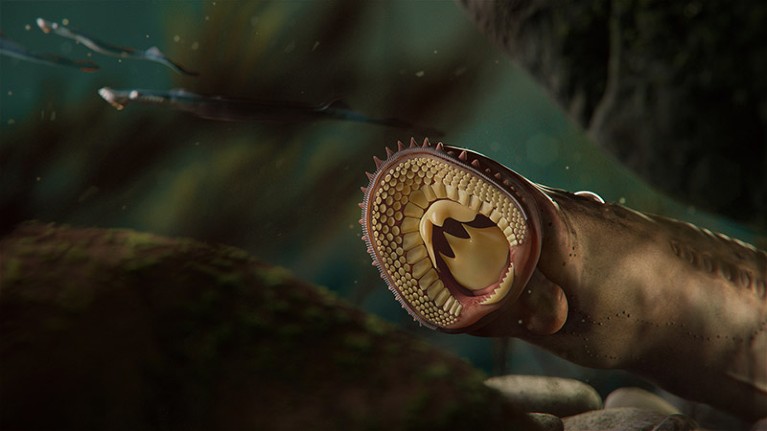Blood
Blood-sucking fish had flesh-eating ancestors
Jurassic lampreys (artist’s impression) used their toothed suckers to consume the flesh of their prey, a strategy that allowed them to grow larger than their ancestors.Credit: Heming Zhang
Under the water on an Earth ruled by dinosaurs, an eerie-looking fish senses its prey. A sudden dart, and it latches onto its victim with a powerful toothed sucker and feasts on its flesh.
This is the picture emerging from a Nature Communications paper1 published today that details two fossil lampreys from around 160 million years ago, during the Jurassic period. These lampreys were fearsome predators, according to the paper, and had probably already evolved the group’s current life cycle, which involves a phase of metamorphosis.
The unusual finds, discovered in northern China, are the closest known fossil relatives of modern lampreys, and are “superbly preserved”, says study co-author Wu Feixiang, a researcher specializing in the evolution of ancient fishes at the Chinese Academy of Sciences Institute of Vertebrate Paleontology and Paleoanthropology in Beijing.
‘Vampire fish’
Often described as living fossils, lampreys — along with hagfish — are one of two surviving lineages of the once-diverse group of jawless fishes. They share a common ancestor with all jawed vertebrates, including dinosaurs and humans. Modern lampreys are widespread in freshwater and coastal seas of cold and temperate areas in the Northern and Southern hemispheres.
They have an unusual life cycle, in which they start life as blind, toothless larva that feeds on microscopic algae and detritus. Like caterpillars, they then undergo metamorphosis to their adult form, which has a sucker-like mouth with rings of sharp teeth. Some modern lamprey species are sometimes billed as ‘vampire fish’ because they suck blood from their prey. However, others don’t feed at all in adulthood — and lampreys are the only known vertebrate with this trait.
Wu says his team’s finds have shed light on a “black box” in lampreys’ evolutionary history. Despite having existed for about 360 million years, lampreys have left scant trace in the fossil record: their cartilaginous skeletons and keratinous teeth do not preserve well. Before this study, only seven fossil lamprey species had been discovered, and five of these lived in the Palaeozoic era, 550 million to 250 million years ago.
Tetsuto Miyashita, a palaeobiologist at the Canadian Museum of Nature in Ottawa, describes the fossils as “impressive specimens”.
“There have been no other lamprey fossils from the dinosaur age that preserve their terrorizing oral apparatus quite so clearly,” he says.
Evolution of a predator
Wu and his co-authors revised the lamprey family tree after studying the two fossil lampreys. They found that the lampreys’ teeth differed radically from those of their Palaeozoic kin. The earlier lampreys had very small and simple teeth and might have survived by scraping organisms off the hard body surface of other aquatic animals.
But the latest study shows that by the Jurassic period, at least some lampreys had become predators, consuming the flesh of their prey. They developed a strong biting mechanism and were larger than their earlier relatives.
The shift was probably driven by the emergence of abundant thinly scaled prey.
To Margaret Docker, a lamprey biologist at the University of Manitoba in Winnipeg, Canada, the fossils’ large body size is significant.
“At over 600 millimetres in length, they are far greater than any fossil lamprey yet described — the largest of which is barely over 100 millimetres in length — and on par with some of the largest modern lampreys,” she says.
This could provide clues to a question that intrigues scientists: at what point did lampreys evolve a metamorphic lifecycle?
Wu says the switch in diet and a metamorphosis might be interlinked. A larval diet of algae does not allow lampreys to grow very large or fast, and early animals might not have survived not being able to eat during the remodelling phase. But once they started eating flesh, adult lampreys would have been well nourished, capable of producing stronger offspring that were better placed to endure the barren period of metamorphosis.
Docker says the discovery of the big fossil lampreys confirms earlier hypotheses that larger body size evolved between around 250 million and 200 million years ago.
But even with such ancient lineage, lampreys have not remained unchanged over time. In 2006, Miao Desui, then a palaeobiologist at the University of Kansas in Lawrence, and his co-authors reported2 a fossil lamprey from about 125 million years ago, discovered not far from where Wu’s fossils were found.
Miao, now retired, is surprised that Wu’s fossils are “quite different” from his team’s, which implies a “greater diversity” in ancient lampreys than previously thought.
The differences show that lampreys have adopted different life strategies over evolutionary time, says Miao. “Apparently, lampreys have been gradually evolving, not as unchanged as we once believed.”

